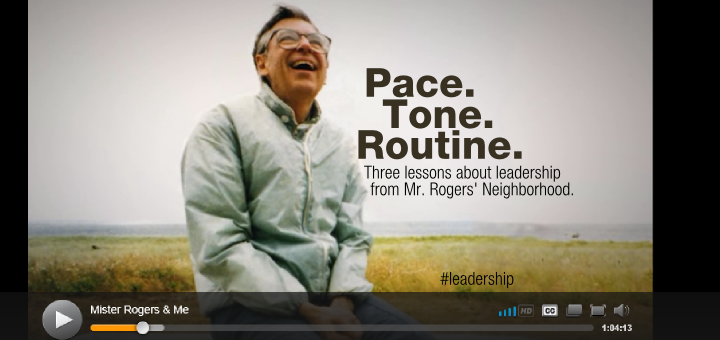I recently caught a documentary on PBS about Fred Rogers and his 31 seasons of Mr. Rogers’ Neighborhood. I learned so much from his show as a child, and I found, as I watched the documentary, I was still learning… but instead of learning about kindness, feelings and how to make crayons, I discovered I was learning about how to be a great teacher and leader. You see, the way Mr. Rogers taught three generations of preschoolers turned out to be just as important as what he taught us.
And there is one thought I just haven’t been able to shake: Mr. Rogers attributed the success of his show not to his own charisma or character, but to its pace, tone and routine.
Now, I wouldn’t disregard charisma or character as essential qualities for leaders and teachers, nor call into question Mr. Rogers’ own character… but perhaps it’s time to elevate these three values as well:
1. Pace.
My sons are both runners, and they understand the importance of pace… not just of running fast, but of choosing a pace that allows for long-term success. They both know that the winner is the person who crosses the finish line first, not the person who is ahead after one mile, two miles… or even three.
In fact, Josh takes pride in never being passed during a race. He knows the pace he can run, and he runs it consistently. Even as other runners are becoming winded and slowing down, Josh just continues to move forward in the pack.
My coworkers know it’s me coming down the stairs to our office; they can tell by the rapid clomp, clomp, clomp of my feet. I take long strides, walk fast and generally move about a slightly forward-leaning angle. But what my team needs is consistency from me, steady and even… not a manager who hustles around, hurried and never stopping to engage.
2. Tone.
Recently I wrote about Newton, our parrot. He can be a pleasant bird to listen to—even chat with—but he can also let out a frightful squawk that will send shivers down your spine. But you’ll probably remember from your own childhood that Mr. Rogers never did. His voice was calm and quiet, slightly above a whisper.
His tone modeled for his audience the kind of attentiveness that was necessary to be a great learner, and he used his cool demeanor to capture and control the energy of children for decades.
So, besides a pace that produces success over the long term, teams also need a calm voice, that speaks truth and wisdom and models the kind of care and attention that each of us craves.
3. Routine.
They might as well have painted his footsteps on the floor, because you would recognize every step Mr. Rogers took at the beginning of the show: past that stoplight, a sprinkle of food for the fish, the sweater, the slippers… It was a routine that said, it’s time for Mr. Rogers’ Neighborhood.
All of us benefit from that sort of routine in our lives. Our teams need to know where and when to find us, when it’s time to work, when it’s time to talk, and when it’s time to listen. Our own schedules even benefit from the simple rhythms of a daily routine: checking and responding to emails and phone calls, blogging, devotions… whatever it is that engages you for the day ahead.
How does your pace need to change?
What does your regular tone say to the people around you?
What elements do you need to build into your daily routine today?
